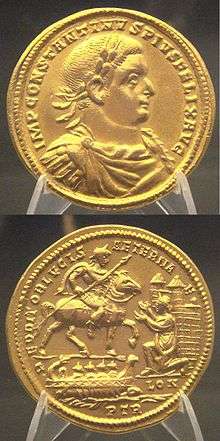Beaurains Treasure
|
The candelabra from the Beaurains Treasure as displayed in the British Museum | |
| Material | Silver |
|---|---|
| Created | 3rd Century AD |
| Present location | British Museum, London |
Discovery
The treasure was accidentally discovered inside a pottery vessel during building work at Beaurains, Pas-de-Calais on 21 September 1922. Two Belgian workmen were digging for clay when they unearthed the treasure a short depth underground. Unfortunately much of the treasure disappeared overnight and a great part of it was sold on the antiquities market. Items from the Beaurains Treasure are now found in collections worldwide, but the two institutions with the greatest proportion of the hoard are the Musée d'Arras and the British Museum.
Description
The Beaurains Treasure is principally composed of coins, although other luxury items are included in the hoard. There are twenty-three pieces of jewellery (necklaces, bracelets, earrings, buckles, finger rings, cameos and pendants), silver objects (a lamp stand or candelabra, two spoons and an ingot) and 472 coins that were kept in a (now lost) silver container, including at least 25 gold medallions issued during the reign of Constantine I. The medallions were minted in Trier and Rome and were probably gifts received by the owner of the treasure during his career as officer of the imperial army between 285 and 310 A.D. Their value ranges from four to ten aurei, and from one and a half to nine solidi. One of the medallions was issued to celebrate the reconquest of Britannia by Constantius I in 296 A.D, the reverse of which is denoted by an image of Londinium, represented by a woman welcoming the Emperor on her knees outside the city walls. The original is kept in Arras, with a copy in the British Museum.[2]See also
Gallery
-
Various necklaces and bracelets from the treasure displayed in the British Museum
-
Bracelets, cameos and pendants inset with precious stones
-
Detail of one of the bracelets set with emeralds, garnets, amethysts and glass
-
Gold and silver coins and one of the gold medallions from the find
-

Copy of the famous gold medallion of Constantius I capturing London in the British Museum
References
- ↑ British Museum Collection database page
- ↑ British Museum Collection database page
Further reading
- D. Strong, Greek and Roman Silver Plate (British Museum Press, 1966)
- L. Burn, The British Museum Book of Greek and Roman Art (British Museum Press, 1991)
- S. Walker, Roman Art (British Museum Press, 1991)
- P. Bastienand & C. Metzger, Le Trésor de Beaurains (dit d'Arras), Arras, 1977